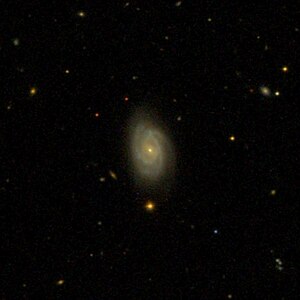NGC 4511
| Galaxy NGC 4511 |
|
|---|---|

|
|
| SDSS recording | |
| AladinLite | |
| Constellation | Big Bear |
|
Position equinox : J2000.0 , epoch : J2000.0 |
|
| Right ascension | 12 h 32 m 08.1 s |
| declination | + 56 ° 28 ′ 16 ″ |
| Appearance | |
| Morphological type | Sb |
| Brightness (visual) | 14.1 mag |
| Brightness (B-band) | 14.9 mag |
| Angular expansion | 1.1 ′ × 0.5 ′ |
| Position angle | 9 ° |
| Surface brightness | 13.3 mag / arcmin² |
| Physical data | |
| Redshift | 0.015421 ± 0.000083 |
| Radial velocity | 4623 ± 25 km / s |
|
Stroke distance v rad / H 0 |
(211 ± 15) · 10 6 ly (64.6 ± 4.5) Mpc |
| history | |
| discovery | William Herschel |
| Discovery date | March 17, 1790 |
| Catalog names | |
| NGC 4511 • PGC 41560 • CGCG 293-027 • MCG + 10-18-063 • 2MASX J12320816 + 5628159 • GC 3061 • H III 834 • h 1319 • GALEX ASC J123208.24 + 562816.9 • LDCE 898 NED003 | |
NGC 4511 is a spiral galaxy of Hubble type Sb in the constellation Ursa Major at the northern sky . It is an estimated 211 million light-years from the Milky Way and about 70,000 light-years across.
The object was discovered on March 17, 1790 by the astronomer William Herschel using his 18.7 inch reflector telescope.
